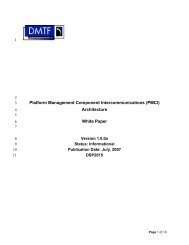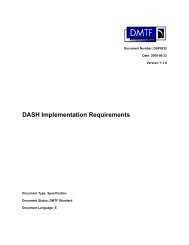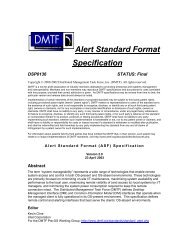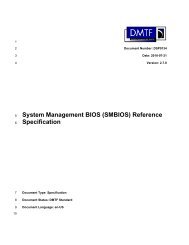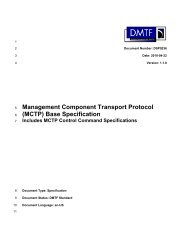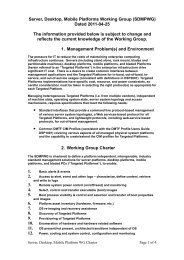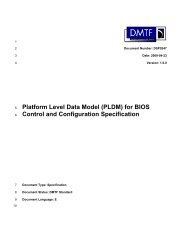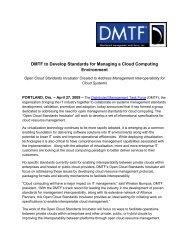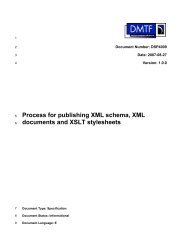Server Management Command Line Protocol Specification - DMTF
Server Management Command Line Protocol Specification - DMTF
Server Management Command Line Protocol Specification - DMTF
You also want an ePaper? Increase the reach of your titles
YUMPU automatically turns print PDFs into web optimized ePapers that Google loves.
<strong>Server</strong> <strong>Management</strong> <strong>Command</strong> <strong>Line</strong> <strong>Protocol</strong> (SM CLP) <strong>Specification</strong><br />
658<br />
659<br />
660<br />
661<br />
662<br />
663<br />
664<br />
665<br />
666<br />
667<br />
668<br />
669<br />
670<br />
671<br />
672<br />
673<br />
674<br />
675<br />
676<br />
677<br />
678<br />
679<br />
680<br />
681<br />
682<br />
683<br />
684<br />
685<br />
686<br />
687<br />
688<br />
689<br />
690<br />
691<br />
692<br />
693<br />
694<br />
695<br />
696<br />
697<br />
698<br />
699<br />
700<br />
5.1.3.4 Target Managed Element Object Model and Semantics<br />
The CLP is designed for administrators and scripts that manage systems. At the same time, the CLP<br />
conforms to the object model described by the 132H4HCommon Information Model (CIM) Schema, version<br />
2.12.<br />
The CLP defines a set of general command verbs used to manipulate Managed Elements. In many<br />
cases, CLP verbs relate directly to typical object interactions, such as "set property value", "read property<br />
value", "put into a particular state", and so on. In other cases, CLP verbs are interpreted in the context of<br />
the Managed Element and map to particular methods of that Managed Element’s class.<br />
The CLP verb definitions in Clause 133H6 describe each CLP command verb in detail.<br />
134H32HDSP0216 describes the full mapping of the CLP to the CIM. For each CIM class, 135H32HDSP0216 describes the<br />
behavior of commands applied to a target instance of the class. The specification also describes the<br />
property names of those targets that are referenced or manipulated by the command.<br />
In the CLP, Managed Elements have the following aspects:<br />
• Properties<br />
These are properties of the Managed Element itself and are described in more detail in 136H5.1.4.<br />
• Contained Targets<br />
This is the set of Managed Elements immediately contained in the Managed Element according<br />
to the rules of instance containment described in 137H5.1.3.5.<br />
• Associations<br />
This is the set of associations that reference the Managed Element. They are described in more<br />
detail in 138H5.1.5.<br />
• Verbs<br />
This is the set of commands that are applicable to the Managed Element. The SM CLP verbs<br />
are described in Clause 139H6.<br />
5.1.3.5 Target Addressing<br />
CLP target addressing is defined by 140H5HDSP0215. CLP implementations shall operate only on command<br />
target terms that adhere to 141H5HDSP0215 or to the rules for identifying OEM targets described in 142H5.2.6.<br />
The specific arrangements of Managed Elements that a MAP may expose are documented in 143H5HDSP0215<br />
and SMASH Implementation Requirements (144H33HDSP0217). The SM CLP separates Managed Elements into<br />
two categories of targets: CLP Targets and OEM Targets. CLP Targets are Managed Elements whose<br />
properties, behavior, UFcT, and so on are wholly defined by the profiles approved for use with the CLP.<br />
OEM Targets are Managed Elements whose properties, behavior, UFcT, and so on are outside the scope<br />
of the profiles approved for use with the CLP and are vendor dependent.<br />
5.1.3.6 Aggregated Targets<br />
<strong>Command</strong> targets may be an aggregation of underlying components. These underlying components may<br />
be visible in the address space of the MAP. When the command target is composed of aggregated parts,<br />
the <strong>Command</strong> Processor shall interpret the command for the aggregated target as a single job and return<br />
a <strong>Command</strong> Response accordingly.<br />
The implementation may rely on the target Managed Element to implement the aggregated command<br />
function. One example of an aggregated target is an operating system. When a user issues a stop to an<br />
operating system instance, a single job is spawned. The operating system may attempt to shut down<br />
applications running within it. This action taken by the operating system is not modeled with jobs, and the<br />
results for individual applications are not displayed in the <strong>Command</strong> Results.<br />
20 Version 1.0.2



